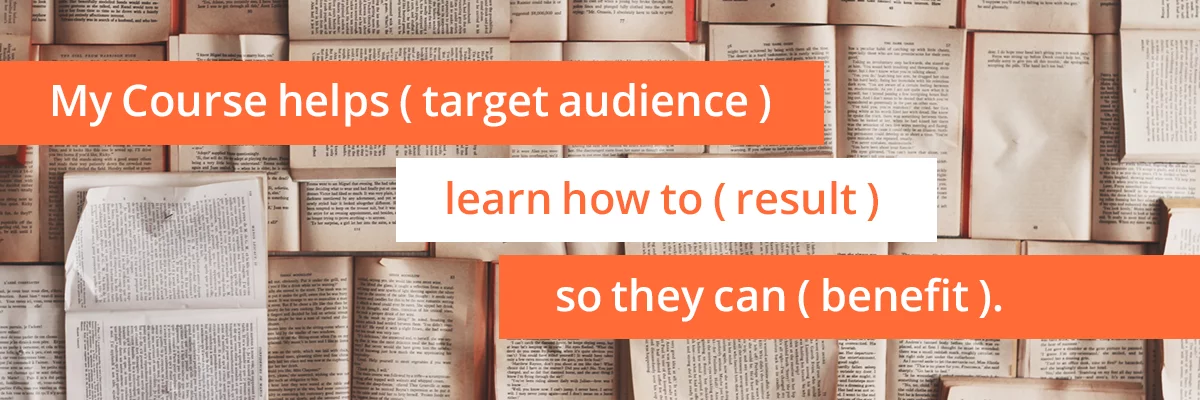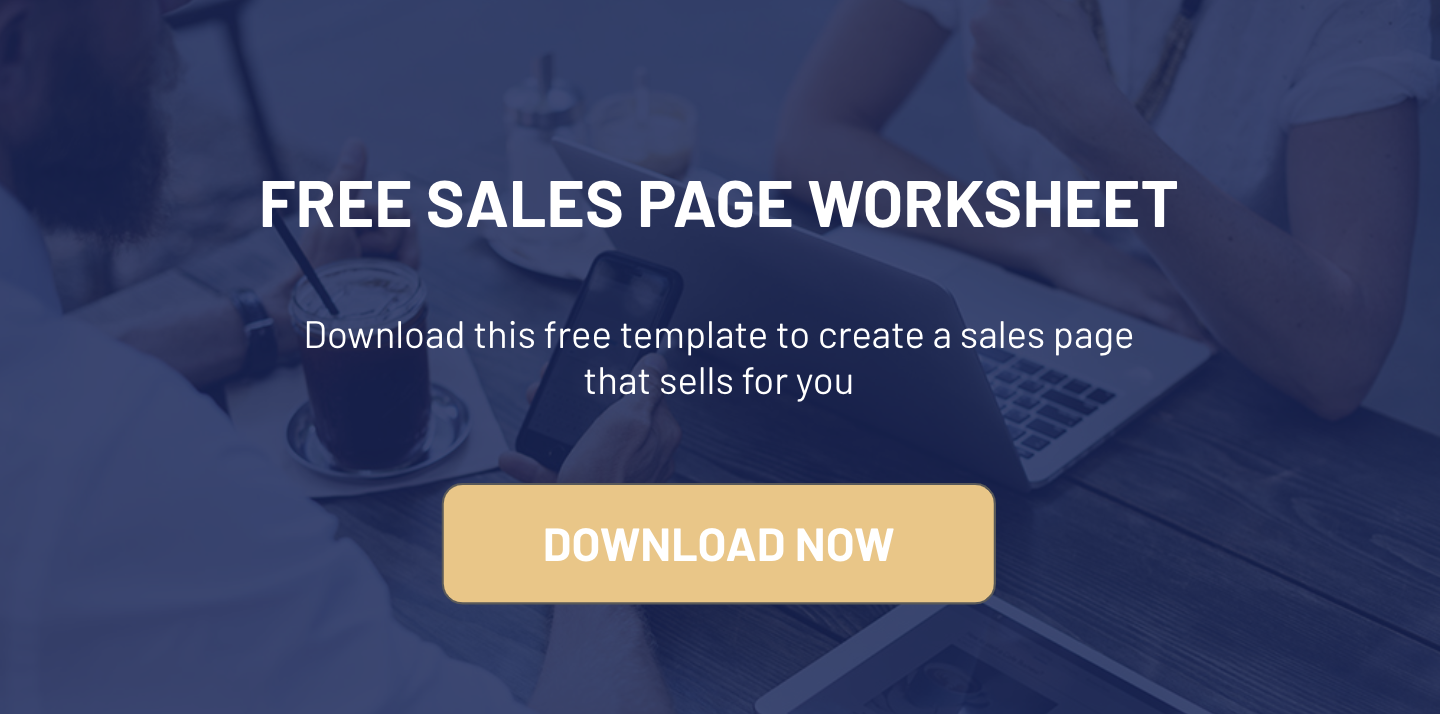Like most online course creators, it has probably taken you several years and a lot of trial and error to learn what you teach in your course. You’re proud of your content, you know it can help someone, and you’re excited to enroll some students.
But just because you created an online course doesn’t mean that the world is going to beat a path to your door and sign up for it. Plus, your course is online, which means that your students can be from pretty much anywhere in the world as long as they have an internet connection. So you won’t exactly be meeting each of your prospective students over a cup of coffee to tell them how great your course is and convince them to sign up for it.
Even if you could find the time to personally speak with every single one of your prospective students, you probably wouldn’t want to anyway. Sales calls are hardly something you’re interested in doing. Like most course creators, your strength is teaching, not selling.
So what do you do? How do you sell your course without trading your precious time to convince someone to sign up for it?
Answer: by creating a sales page that sells it for you.
We created a free Course Sales Page Worksheet that you can download. This is a fillable PDF document that you can use to start planning and organizing the content for your sales page. To download this free resource, simply enter your email below:
Your course sales page (also known as your course description, landing page, or sales letter) is the page that describes your course, but more importantly, persuades someone to enroll in it. It’s the page that your prospective students visit before making the decision to sign up – or not sign up – for your course.
How someone finds your course sales page is not important (well, actually it is pretty important but just not for the purpose of this article). Maybe they heard you mention your course on a podcast and decided to check it out. Maybe they clicked on an ad that you placed on Facebook. Maybe they clicked on the link in an email you sent them. Maybe they read an article on a blog that recommended it. Maybe they just watched you present your course on a live webinar. Or maybe they found it on their own after doing a Google search for a course about your topic.
Regardless of the marketing strategy that was used to get someone to your sales page, the important thing is what they do once they get there.
Before we go any further, you should know that I tend to use the terms sales page, course description, and sales letter interchangeably. Regardless of which term I use, know that I am referring to the same thing. Call it whatever you want, but the page that I am going to show you how to create is the page that sells your course.
Note: I also recorded a video where I discuss the elements of a sales page, and show you two examples of really well-designed online course sales pages. To watch the video, check out this episode of Teach Online TV.
Before you write a single word, know these 3 things:
Okay, before you write a single word of your course sales page there is something very important that you need to understand.
Your sales page has one goal, and that is to persuade the reader to sign up for your course (even if your course is free!). That’s it. Every word on your sales page must contribute to the accomplishment of that goal.
Your sales page is not the same thing as your course outline (although your course outline should certainly be a part of it). And it’s definitely not a page that you should write to impress a high school English teacher. You’re not writing an essay. You’re writing a sales letter. The purpose of a sales letter is to influence someone to make a decision. When someone finishes reading your sales page, they are going to decide whether or not they want to take your course.
Unfortunately, writing a compelling sales page is not a skill that any of us are born with. The ability to write compelling copy is a skill that takes years to develop. That’s why expert copywriters are able to charge a significant amount of money for their services because they know how to write sales letters that generate thousands, and in some cases, millions of dollars in sales for their clients.
According to Derek Gehl (former CEO of the Internet Marketing Center) who has generated millions of dollars in sales of information products and online courses, copywriting is the most valuable skill that an entrepreneur should learn.
That being said, I’m going to make an assumption about you, and that assumption is that you are not an expert copywriter (kudos to you if you are, though). If that’s true, that is perfectly okay. The good news is that you probably understand your course topic and your target audience better than most people do.
By giving you a little guidance and a proven structure to use, my goal is for you to be able to piece together a compelling sales page that helps increase the number of students that sign up for your course.
Copywriting is salesmanship in print
In 1904, a man named John E. Kennedy came up with a brilliant definition for the word advertising. Kennedy defined advertising as salesmanship in print. And although this was more than one hundred years ago, that definition still holds true today (with the exception of the term print of course, since many advertisements now exist in digital form).
Like advertising, copywriting is the ability to persuade someone using the written word. But in order for your copy to be effective, there are a few questions you need to answer before you start writing. Once you have the answers to these questions, you can craft a sales page around your responses.
Here are the questions:
1. Who is your course for?
Firstly, identify who your course is for. Who is your target market? Who are the people that will most likely be interested in your course? Don’t worry so much about surface level demographic information such as their age, profession, their level of education, etc. This type of information is helpful, but it doesn’t tell you why they will sign up for your course.
What is your target market struggling with? What challenge are they trying to overcome? What pain are they trying to avoid, or alternatively, what pleasure are they trying to gain? Understanding what motivates your target market to enroll in a course is more important than knowing their demographic information. No one buys a course. They buy a solution to their problem.
2. What does it help them do?
Secondly, identify what your course helps your student accomplish. What does learning what you teach help them to do? What problem does it help them solve? What is the specific result they can achieve by implementing what they learn from your course?
“The more accurately you can describe your reader’s problem in terms they can relate to, the more they instinctively feel that you must have an answer to that problem.” – Jay Abraham
3. Why is that beneficial to them?
Lastly, identify the reasons why your student wants to achieve the result that your course teaches them to achieve. How will that help them? Will it help them advance in their career? Will it help them improve the quality of their relationship with their spouse? You need to be able to communicate the advantage of learning what you teach.
Tie your answers together in a single sentence:
Once you’ve answered these questions, tie them together in a single sentence using the framework below. When you say this out loud, it should sound just like an “elevator pitch” for your course. But instead of calling it an elevator pitch, let’s call it a Unique Value Proposition (this sounds a lot cooler than an elevator pitch, don’t you think?).

If you create a communication course for couples, for example, here’s what this completed sentence might look like:
“My course helps couples learn how to communicate with each other effectively so they can argue less and enjoy a loving and fulfilling relationship together.”
If you haven’t already, make sure you download our free Course Sales Page Worksheet. This worksheet includes a section for you to complete this exercise.
3 types of sales pages:
Now that you’re armed with the clarity of who your course is for, what it teaches them to do, and why that is beneficial to them, it is time to start working on your course sales page. Your sales page is essentially where you expand upon these elements in more detail.
There are pretty much only 3 types of sales pages that are used to sell online courses. They all serve the same purpose (to persuade someone to sign up for your course) and they can all be effective, so feel free to use any one of these types.
The first type of sales page is the text-only sales page:
Often called a long-form sales letter, all of the content on this type of page is in text form. It is also helpful to include images throughout the page to help support the text, and to improve the overall look and design of the page.
The second type of sales page is the text and video sales page:
This type of page includes a combination of text and video content. The video portion of the page is often a shorter version of the written content or an introduction to the course. It could also be a full-length sales video that includes all of the same elements as a long-form sales letter, giving the reader the option of watching the video or reading the page, or both.
The third type of sales page is the video sales letter:
A video sales letter (called a VSL, for short) can be extremely effective if done correctly. A high-converting VSL will contain all of the same elements as a long-form sales letter, and is typically scripted to ensure its effectiveness. In fact, if you transcribe a high-converting VSL, you should end up with written content that resembles the content in a long-form sales letter. With this type of sales page, the link to purchase your course would be placed below the video.
Structure vs. Content
As you create the sales page for your course, there are two things you’ll want to consider. The first is the structure. The second is the content. Can you guess which one is more important?
The answer is neither. Structure and content are both equally important. Great content with bad structure doesn’t work very well. And great structure with bad content doesn’t work very well either. Your sales page needs to have compelling content, and that content needs to be presented in a specific order in order to be effective.
“The online course industry has become quite competitive in the last few years, and there seems to be a hundred courses for every single topic. What does that mean for your course sales page? When someone compares your course with other similar courses (as they most likely will), your course must stand out as the best. It must have the best reviews, the fullest and most interesting curriculum, and persuasive sales copy that convinces them to buy.” – Alex Genadinik
What to include on your online course sales page
If you type the words “how to write a sales page” into Google, you will be presented with literally millions of results, each one recommending a specific structure for a sales page. I’m definitely not against reading those articles and looking at examples of sales pages (I’ve personally looked at hundreds of online course sales pages over the years), but once you’ve seen a few you’ll likely start to notice a pattern between them.
The most effective sales pages for online courses typically contain most, if not all, of the elements outlined below:
- A compelling headline (to capture attention)
- An opening story (to introduce the problem)
- Bullet-points (to highlight benefits of the solution)
- The solution/offer (introduce your course)
- Bonuses (to increase perceived value)
- Testimonials (for social proof)
- Credibility (instructor bio)
- FAQ (to overcome objections)
- Pricing details (with a clear call-to-action)
- Risk Reversal (a satisfaction guarantee)
The order in which these elements are presented may vary somewhat, but in most cases, they are always there. These are the basic building blocks of a course sales page. Let’s have a look at each one in more detail:
The Headline
The purpose of this headline is to grab your reader’s attention and make them want to keep reading. That’s it. It is NOT to sell your course. In fact, you probably shouldn’t even mention your course in your headline.
Think of your headline as the ad for your sales page. If all your target audience sees is your headline, would it make them want to keep reading?
Qualify your reader with your headline. Make it obvious who the headline is for. This gives your reader the chance to determine if the sales page (and therefore, your course) is relevant to them. If it is, they will pay attention.
“If you don’t nail the headline (the single most important part of your sales letter), no one will stick around for the rest. Your headline must pre-qualify the reader based on their needs and wants, as well as promise them an intriguing result if they’ll stick around and read what comes next.” – Dave Navarro
Opening Story
Now that you’ve got your reader’s attention, the next thing you want to do is present the problem that they are experiencing. Show your reader that you understand their current pain or frustration. This helps to build rapport with your reader because it demonstrates empathy.
If you’ve experienced the same frustration (before you discovered the solution) that your reader is experiencing, share that story with them. Define the problem, and remind them of the cost of not solving it. When you define the problem first, introducing your solution becomes a natural transition.
Remember, no one buys a course. What they buy is a transformation. Help your reader visualize the transformation that they want to create before you introduce your course to them.
“Amplify the consequences of not solving the problem, and the aspirations they hold for the future. This is really the key to making sales, and it is probably the most neglected step in the process.” – Ray Edwards
Bullet Points (Benefits)
A bullet point is a short statement that identifies a single benefit of your course. In this section of your sales page, you should list the main benefits (5-10 is a good amount) that your course is going to help them experience.
Since many readers will skim your sales page before they actually read any of the paragraphs, you want it to be really easy for those skimmers to find these benefits. Don’t hide these benefits inside long paragraphs.
“Too many ideas sends the reader’s mind in too many directions. You can use any number of different stories, predictions, statements or promises, but they all have to support that one Big Idea that your reader will grasp immediately.” – Amy Porterfield
The Solution/Offer (Your Course!)
This is where you present your course. Show the reader what is included in your course. List the modules and/or video lessons, and tell them what they will learn from each module or lesson.
Remember that as you describe the content in your course, tie that content to specific benefits. What does each lesson help them do? Why is that beneficial for your student?
“If you want to pull the reader into the content of your sales page, it’s important to connect with your reader on a deep EMOTIONAL level right from the start. One way to do that is to communicate the reader’s current PAIN or future PLEASURE. The fact that all human behaviors are driven by either avoidance of pain or pursuit of pleasure makes this type of opening a powerful start.” – Tal Gur
Bonuses
Include a list of any bonus materials and resources that are included in your course. These are meant to supplement your course material and enhance the overall learning experience for your students. They also help to increase the perceived value of your course.
Here are some examples of bonuses that you could offer:
- Downloadable resources (checklists, worksheets, PDF guides, etc.)
- Access to a private group with other students
- 1-on-1 or group coaching calls with you
- Direct email access to you
- Monthly live calls or webinars with you
- Discounts or deals on other products or services (like software, for example)
- Course completion certification
Attaching a dollar value to each bonus is a great technique for increasing the perceived value of your course. If the sum total of the value of all the bonuses exceeds the selling price of your course, this helps position the price of your course as a bargain. People will only buy something if when they value what they are buying more than they value the money they are exchanging for it.
Testimonials
You’ve introduced the problem. You’ve presented the solution (your course). But here’s the thing. Just because you say your course is the solution doesn’t make it true. As the creator of your course, your opinion is biased.
Your reader needs to be assured that your course actually helps them do what you claim it helps them to do. They need proof, and that is why you need testimonials. Testimonials are third-party validation that your course delivers on its promise. They are endorsements from people who have taken your course and are willing to recommend it to others.
Obtain written testimonials from people that have completed your course. Include the name and title of the person, and an image if possible. Video testimonials are the most powerful, so if you can get any of those, you should. A word of caution: never use a fake testimonial. If you don’t have any testimonials yet (because you don’t have any students yet), consider giving free access to your course to a select group of individuals in exchange for testimonials from them.
With Thinkific, you also have the option to collect reviews from your students, and display those reviews on your course sales page.
Credibility (Instructor Bio)
Your instructor biography is the perfect place to showcase your credibility as an instructor. Basically, you want to answer the question: who are you and why should someone listen to you? This doesn’t necessarily mean you need to have formal credentials (from a college or university, for example). In many cases, proof that you achieved the result you teach your students to achieve will be enough. The point is to assure your reader that you have the knowledge and experience to teach them your topic.
“One really effective way to establish credibility on a sales page is to give yourself a title. For example, Ben Settle positions himself as a “World Leader In Email Copywriting Education”. Another example is Justin Brooke who positions himself as “The Traffic Guy Millionaires Recommend”. The key is to position yourself as the one and only, not necessarily the best. It’s an advanced strategy, but it can help you establish rock-solid credibility if you do it right.” – Danavir Sarria
Frequently Asked Questions (FAQ)
Including a FAQ section on your sales page is a very effective way to increase your course sales. The goal here is to overcome the common objections and concerns that your reader may have. If you were giving a 1-on-1 sales presentation of your course to a potential student, what questions would they likely ask you before they decide to buy your course?
Make a list of the 5-10 most common questions a potential student will most likely ask about your course. If you don’t know what they would ask you, a great way to figure that out is to host a live webinar for your audience with a Q&A session at the end. Write down all the questions you’re asked at the end of the webinar and add them to this section.
“Join the conversation that is already taking place in the reader’s mind.” – Robert Collier
Pricing
Technically this part is taken care of for you by the Purchase Buttons that are automatically added to the bottom of the page. That being said, it is still a good idea to actually tell your reader to sign up for your course. You can even insert your own custom button (as an image, for example) and simply link it to the checkout page for your course. Never assume that you reader knows what to do next. Always tell them what the next step is.
Offering different price tiers is also a great way to increase your course sales. Buyers like to compare different options before making a purchase. Different prices give them options to choose from. One of these options can even be a free trial.
Related Post: How to Price Your Online Course
Risk Reversal
At some point in their decision-making process, your reader is going to ask themselves: “what if I’m not happy with this course?” Now is your chance to answer that question for them. Someone who has never met you in person and never bought anything from doesn’t want to risk buying your course and then regretting their purchase.
A common risk reversal technique is to offer a 100% money back guarantee within a specific period of time, such as 30 days. The reason you want to do this is because it takes all of the risk of buying your course off their shoulders. You’re basically saying, “I’m so confident that you will like my course that I’m willing to give you all your money back if you don’t.”
Yes, some people will take advantage of your refund policy and purchase your course with the intention of asking for a refund before the time period expires. But more people will buy your course because you offered a money back guarantee, so, in the long run, you come out ahead.
The P.S.
This one is optional, but I highly recommend adding a P.S. section to the end of your sales page (yes, just like the P.S. that you sometimes add to the end of a letter or an email). An abbreviation for the word postscript, a P.S. is a phrase or a paragraph is added to the end of a completed letter.
If you’ve spent some time looking at other online course sales pages then you probably that a few of them included this at the bottom of the page. The reason they include a P.S. is simple: because they work!
The P.S. section is a great place to summarize your entire sales letter in just a few sentences. Remember, some readers will skim through your page instead of reading every single word. Wrap up your sales page with a personal note to your reader. Give them one last reason to sign up for your course.
“What will motivate people to buy your product, invest in your service, or accept your idea is usually not the beautiful outcome framed in a positive light on its own. It is required rather, that before painting the picture of the “paradise” they seek, you must get them to fully experience the consequence of not solving the problem.” – Ray Edwards
Create a sales page that sells your course to you
Congratulations… you now know how to create a compelling sales page that will help maximize your online course sales. Consider yourself armed and dangerous!
If you haven’t already, make sure you grab our free Course Sales Page Worksheet. You can use this worksheet to help create and organize the content for your course sales page:
This article was originally published in July 2016, and was most recently updated August 2023 with new helpful resources.









